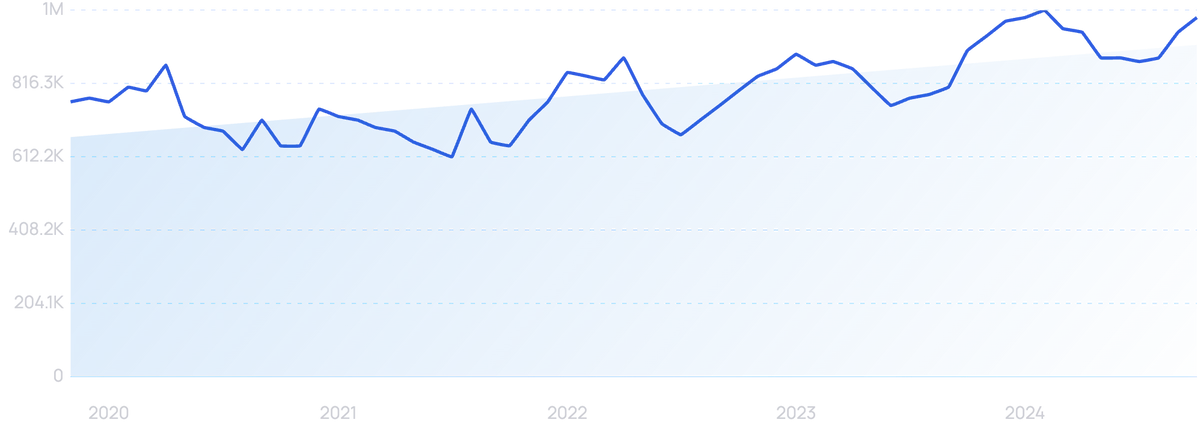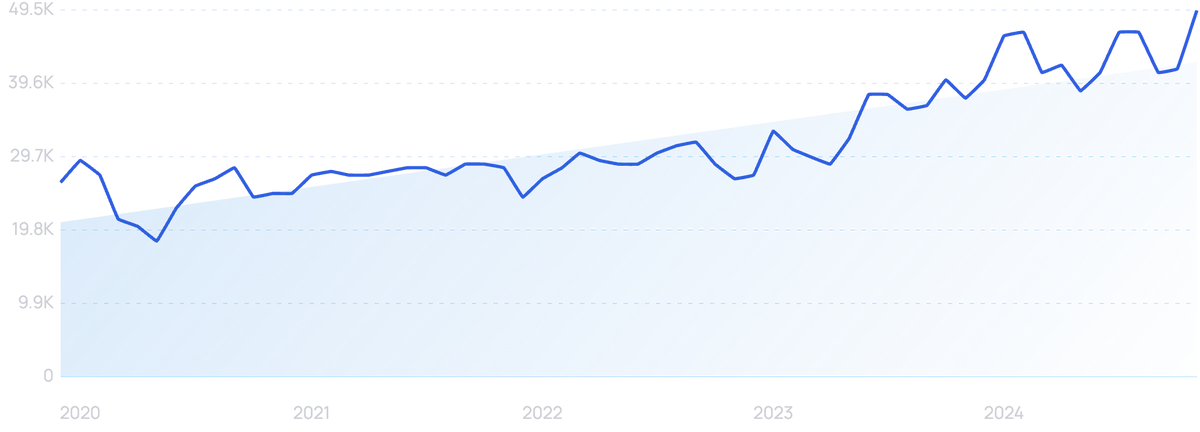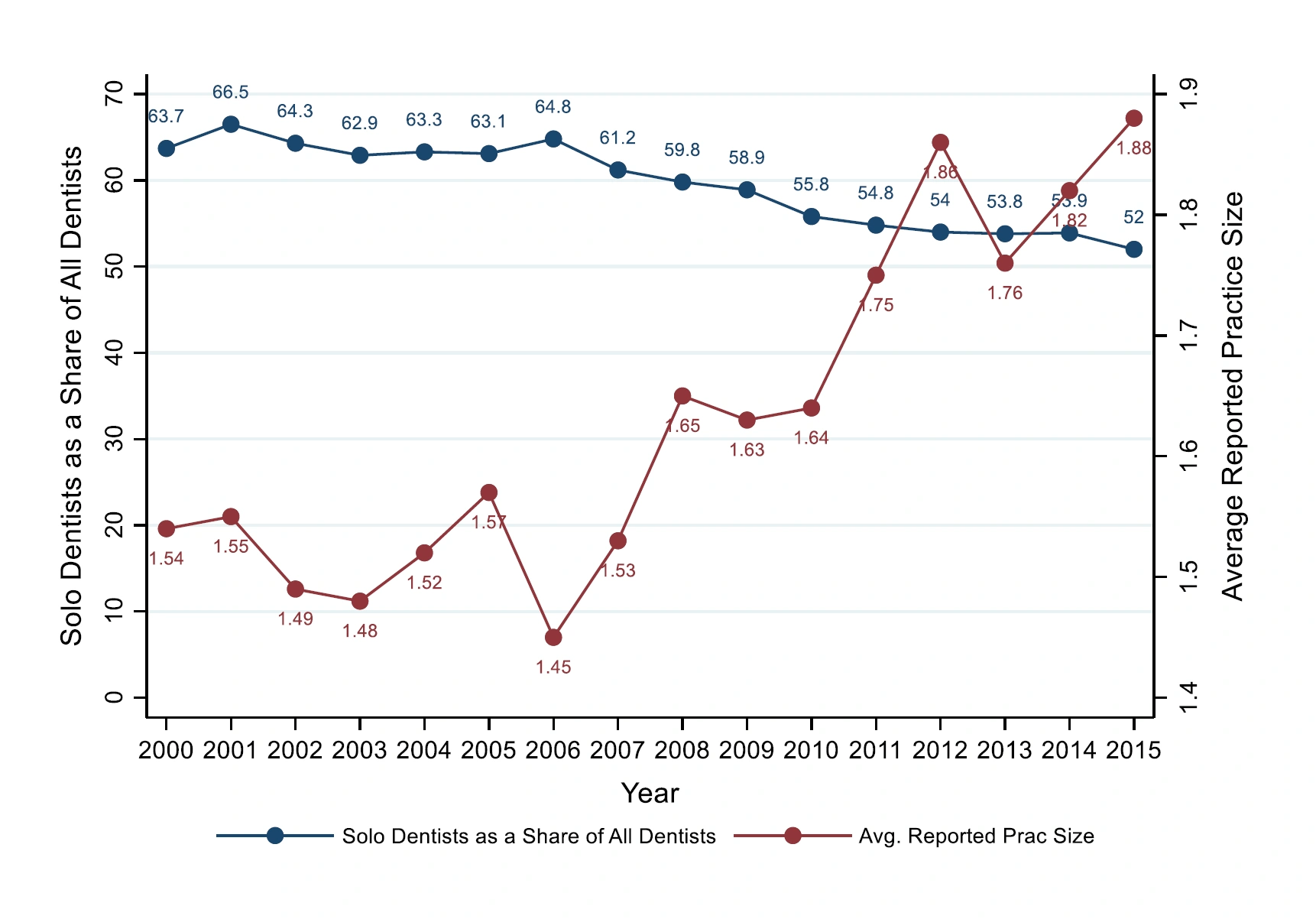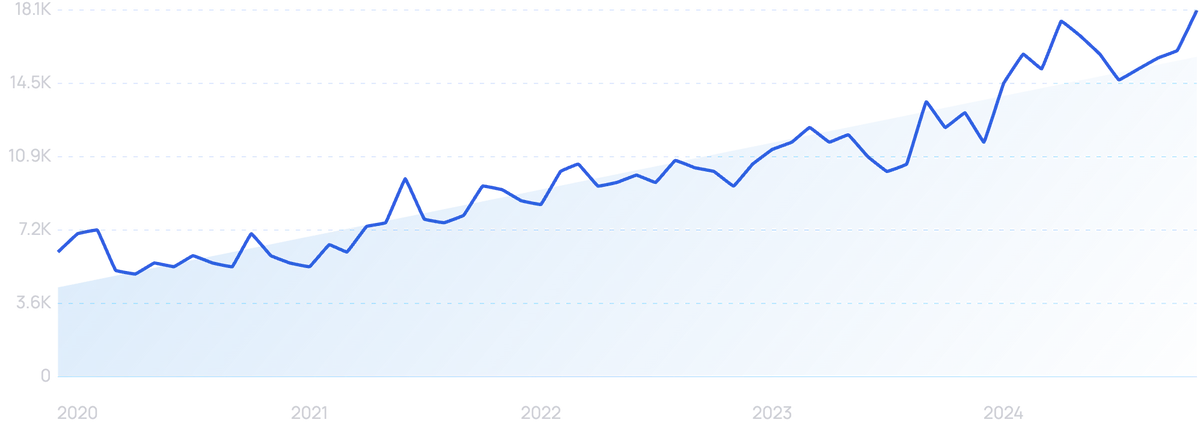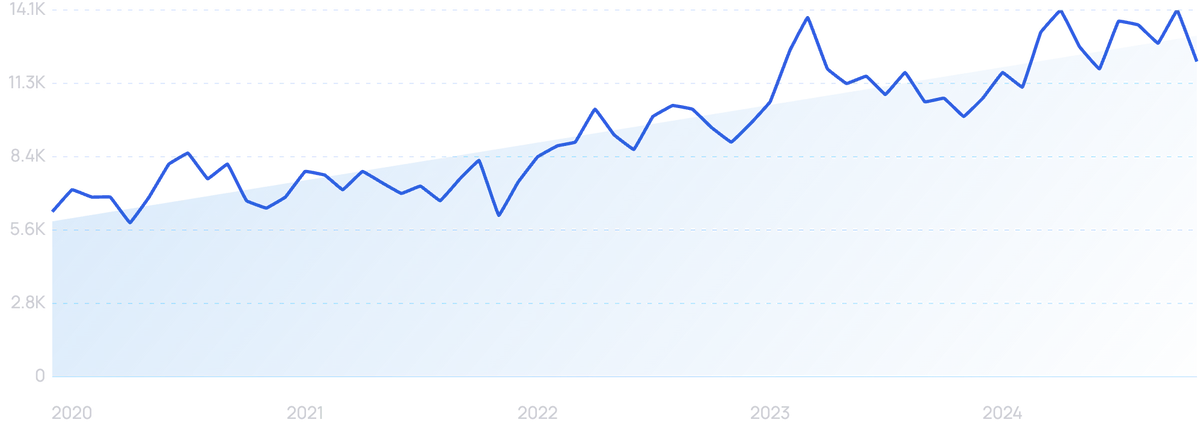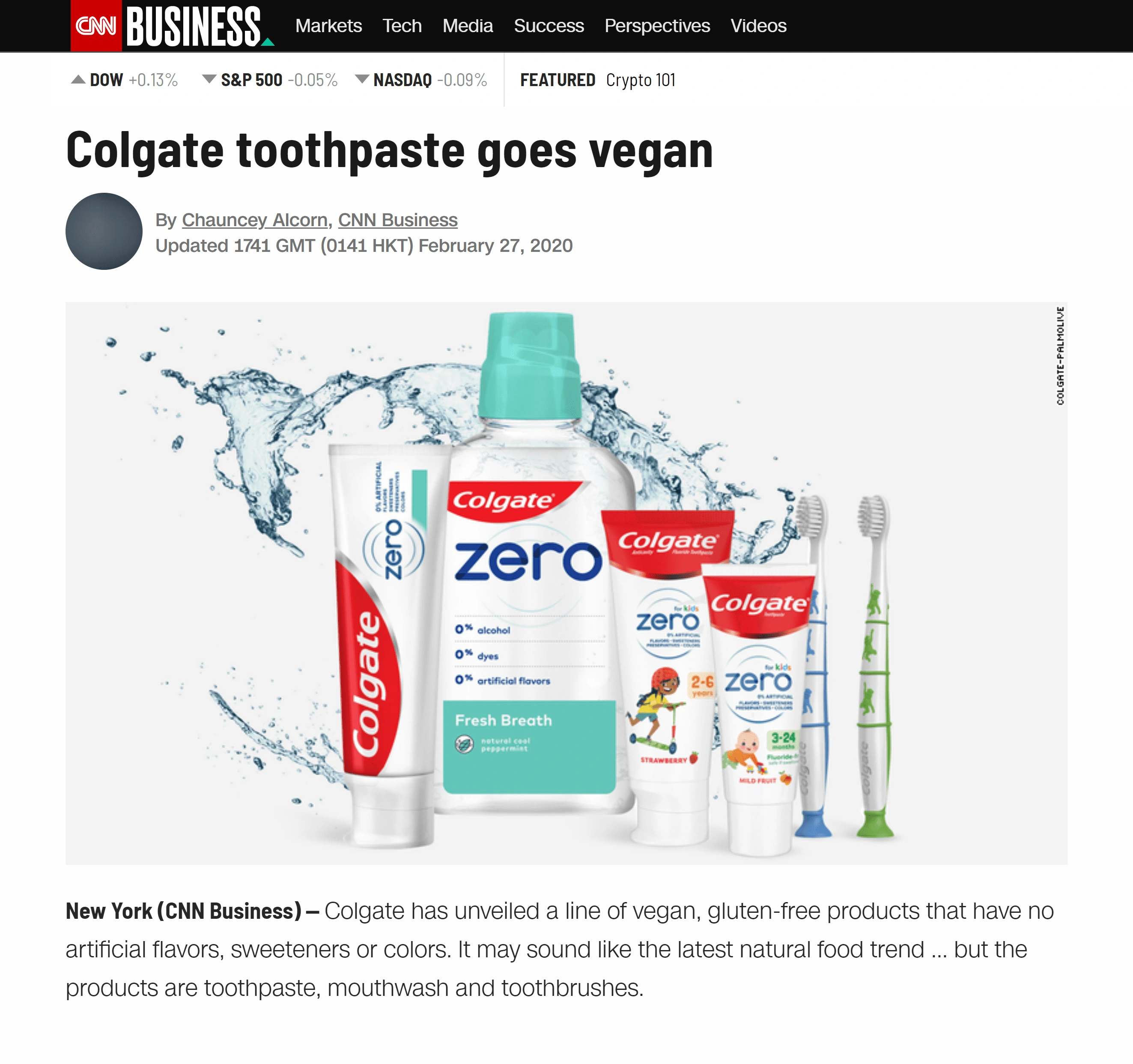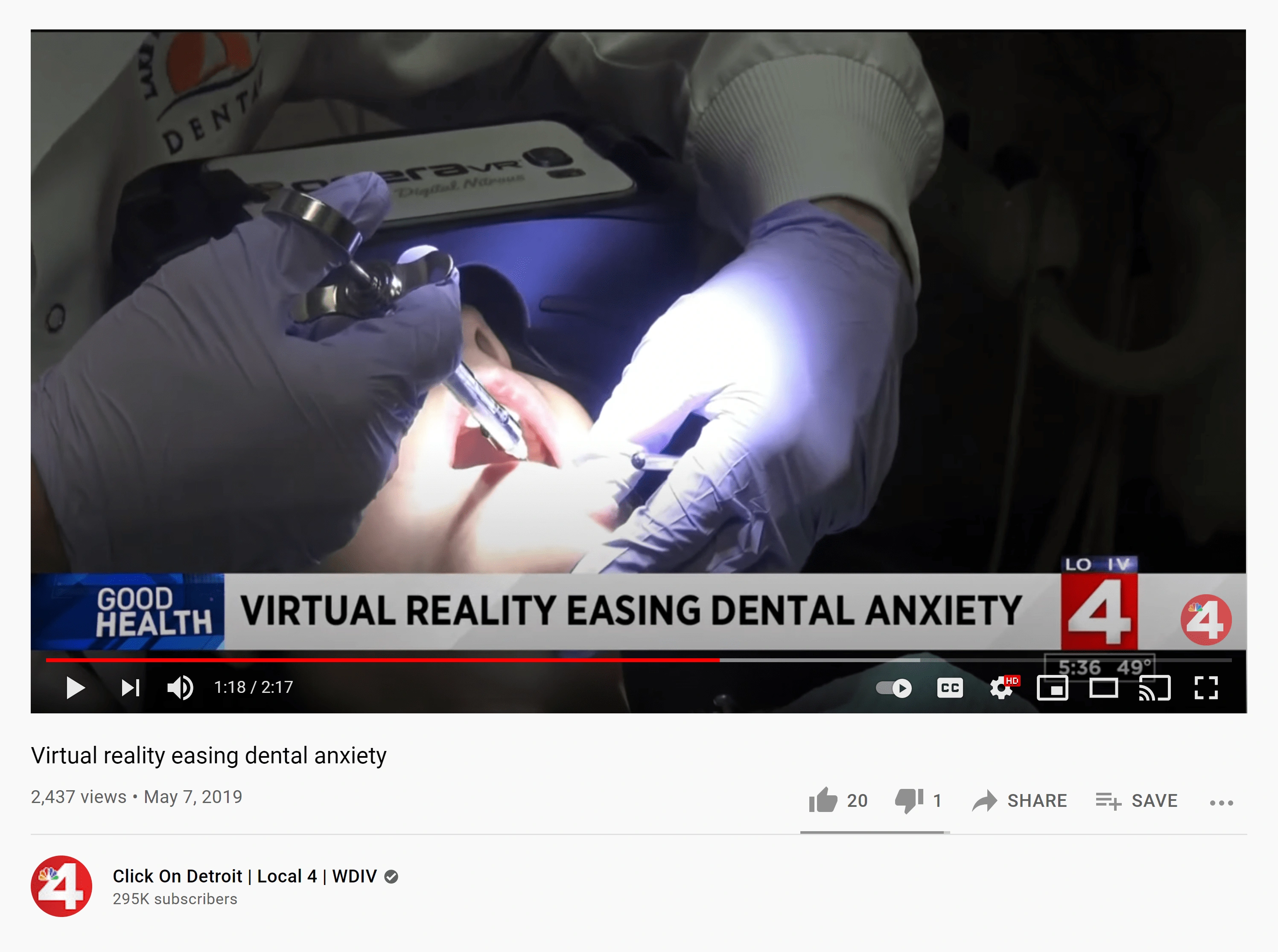
Top 9 Dental Industry Trends (2025-2027)
You may also like:
Dental care spending took a huge dive due to the pandemic.
To adapt to decreased spending and shifting patient needs, the dental industry is seeing rapid adoption of new technologies.
Keep reading to learn more about the trends impacting the dental industry in 2025 and beyond.
1. Dentists Invest in 3D Printing
The global 3D printing market is expected to expand at a rate of 23.5% from 2024 to 2030.
Searches for "3D printing" are up 31% over 5 years.
As 3D printing technologies become more mainstream, dental practices will have greater access to 3D printed materials at lower costs.
Approximately 96% of detail practices with five or more employees use 3D printers.
The Journal of The American Dental Association states that “the low cost and simple workflow of additive 3D printing has the potential to improve precision and efficiency in clinical dentistry for both academic and private practices”.
Dental practices once needed to contract a third party to fulfill various applications.
Today, many practices can handle their 3D printing needs in-house or through lower-cost avenues.
Dental products that can be 3D printed include:
- Dentures
- Clear teeth aligners,
- Dental crown substructures
- Dental models
- Surgical guides
Dental 3D printing market by type from StellarMR.
The dental 3D printing market was valued at $3 billion as of 2023. And is set to grow to $8.1 billion in 2029 (CAGR of 19%).
Similarly, the clear aligners market is expected to grow at a CAGR of 16.7%.
And companies like SmileDirect, Invisalign, and Candid all utilize 3D printing technology.
Searches for “clear aligners” have increased 89% over the last 5 years.
2. Dental Practices Continue to Consolidate
Solo dental practices are declining.
According to the American Dental Association, in 1999, 2 in 3 dental offices were solo.
Today, only 1 in 2 practices are solo.
Additionally, the average practice size increased from 1.54 in 2000 to 1.88 in 2015.
Solo dentists and reported practice size from the International Journal of Health Economics and Management.
Besides group practices, another strategy on the rise is the participation of Dental Service Organizations (DSOs) and Dental Management Service Organizations (DMSO).
DSOs and DMSOs contract with dental practices to provide management and non-clinical support like human resources, accounting, and negotiations with suppliers.
In 2017 7.4% of all practicing dentists were affiliated with a DSO.
This number grew to 10.4% in 2020 and 13% in 2022.
Heartland Dental is the United States’ largest DSO, with over 1,000 affiliated locations.
The main factors driving the industry toward consolidation? Finances.
A recent survey of dental professionals found that 7% of dentists are considering affiliating with a DSO or merging their practices as a result of the pandemic.
And, according to the Academy of General Dentistry, the average cost of dental education has doubled since 2000.
(Increasing from $121,434 to $216,842 for non-residents and $84,819 to $158,119 for residents.)
This growing education investment means that the average dental school grad leaves with $293,900 in student loan debt.
The burden of student debt may be a large reason why only 1 in 4 dentists under 35 are in a solo practice.
3. Dental Practices Go All-In with Digital Marketing
Dental practices have traditionally been small operations without a huge digital marketing budget.
Though slow to catch up, the pandemic underscored the necessity of online advertising for many dental practices.
In a survey of dental practitioners, 38% believed more marketing would make their practice more productive and profitable.
Across all industries, digital ad spending reached an estimated $740 billion in 2024, a growth of 8.9%.
A survey of dental patients found that 1 in 3 say that dentists cannot go without Facebook marketing.
They also found that 58% of patients prefer seeing video content from dental practices.
Social media has become a popular and low-cost channel to help dental practices get in front of new patients.
In 2013, only 86.2% of companies used social media for marketing.
As of 2022 around 92.1% of businesses use social media.
The healthcare marketing platform PatientPop found that providers who don’t address online reputation are 52% less likely to report having strong revenue.
4. Dentists Move Towards Subscription-Based Coverage
34% of adults report avoiding the dentist due to cost.
This is partly because about 27% of people in the US lack dental coverage.
And for those with coverage, it can sometimes be difficult to find a practice covered by their specific insurance plan.
For both insured and uninsured, dental costs can be incredibly unpredictable.
For dental practices themselves, 72% name declining insurance reimbursement rates as their number one concern.
Subscription dental services are a solution for both patients and dentists.
These services offer an annualized or monthly rate that covers regular cleanings, x-rays, and even fillings or other surgeries.
They can be cost-effective for patients while guaranteeing more revenue for dental practices.
Studies show that about 83% of consumers are likely to stay with a dental practice with an in-house dental membership plan.
Subscription dental platform provider Kleer claims an above 80% renewal rate with plan members (the typical dental practice has a 75% retention rate).
5. Increasing Demand for Laser Dentistry
The dental lasers market is expected to grow 7.6% from 2024 to 2030.
Dental lasers are classified by their intended use on either hard or soft tissues.
An example of a medical laser being used in a dental practice.
Laser technology has a range of dental care applications. And in some cases, can even replace the need for a traditional dental drill.
This means that they can be used to remove or reshape tissue, repair fillings, remove cavities, and accelerate whitening procedures.
There are dozens of potential benefits of medical lasers:
Studies have shown that lasers can reduce pain and speed post-op healing while reducing bleeding.
Additionally, one study showed that diode lasers had a 100% reduction in long-term bacteria.
While just 58.4% of those treated with the usual hydrogen peroxide showed improvement.
This low-level laser therapy is one application of photobiomodulation, the application of low-energy light to tissues.
Searches for “photobiomodulation” have increased 194% over the last 5 years.
6. Consumers Demand Natural Oral Hygiene Products
Natural, clean, and sustainable personal care products have all seen increased popularity in recent years.
The global market value for natural cosmetics and personal care is expected to be worth $23.42 billion by 2028, increasing around 35% since 2018.
According to a survey by the consulting firm AlixPartners, 64% of consumers feel it is important to purchase natural or clean personal care products.
Growing natural oral care products include herbal toothpaste, herbal mouthwash, bamboo toothbrushes, and oral supplements.
A recent natural method of maintaining oral health is through the use of oral probiotics.
Searches for “oral probiotic” over the last 5 years.
Oral probiotics like Oralbiotic, are lozenges that dissolve in the mouth and establish a helpful oral microenvironment.
A meta-analysis of existing oral probiotic research completed in 2020 found that they can help prevent halitosis, periodontal diseases, and reduce the prevalence of cavities.
Mainstream toothpaste companies are paying attention to this trend.
In 2020, Colgate announced a vegan sugar-free toothpaste with no artificial colors.
Colgate recently launched an all-natural toothpaste.
Similarly, in early 2021, Crest launched Crest Pure, a toothpaste free of SLS or artificial colors.
7. Teledentistry Goes Mainstream
23% of dental practices were considered teledentistry in 2021.
According to the CDC, telehealth visits increased 154% in the first week of the pandemic.
They remained elevated throughout the year, where nearly a third of all healthcare visits were conducted virtually.
Diedre Keeves, director of connected health application at UCLA Health thinks this trend will continue: "We think that telehealth is here to stay. Our patients are expecting it. Our doctors are very happy with it, and it's a great avenue for care”.
Not only can teledentistry provide a substitute for in-person care, but it can improve healthcare by increasing frequency and improving access.
Teledentistry can make it easier for the 20% of Americans who live in rural locations without easy access to dentists and medical services to obtain care.
Additionally, teledentistry has been shown to be equally effective as in-person initial consultations at diagnosing cavities and assessing treatment plans.
8. New Automated Practice Management Options Emerge
For appointment-setting, customer service, and more management functions, automation will become the norm for many dental practices in the coming years.
Thanks in part to advancements in artificial intelligence, the market for healthcare chatbots is expected to increase 23.9% through 2034, making the market worth $12.2 billion.
Dental chatbots can perform a number of important services.
The Emergency Dental Virtual Assistant can screen emergency patients before they arrive for immediate dental care.
Smartbot360 can answer questions about services, make appointments, or leave a message for a person.
ChatCompose can ask questions about symptoms and refer patients to a particular dentist.
Another kind of automated software on the rise in dentist’s offices is appointment confirmation software.
This software automatically sends reminders via email, text, or phone to patients about their upcoming appointments, and confirms the appointment.
Similarly, review management software encourages patients to leave feedback. Industry research shows that 70% of users will leave a review if asked.
9. Dentists Work to Reduce Patient Anxiety
36% of the population experiences dental anxiety.
And approximately 22% of people report avoiding going to the dentist because of fear.
In one study, student dentists who scored high on emotional intelligence had higher levels of patient satisfaction.
In response to patient avoidance, the dental industry is making strides to mitigate stressful factors like pain and uncertain outcomes.
To remove the fear of the experience completely, practices that specialize in sedation dentistry.
This process involves using medication to induce a relaxed sleep-like state for everything from routine cleanings to fillings.
In the field of cosmetic dentistry, a source of stress may come from uncertainty about results that are going to be life-long.
With that in mind, technology like virtual results mockups using Digital Smile Design (DSD), 3D-printed trials, or a combination increases patient satisfaction.
VR simulations may help reduce patient anxiety before a dental procedure.
Another method for relaxing dental patients involves simple distraction.
The use of VR in medicine has been shown to significantly reduce a hospitalized patient’s perception of pain. And improve the overall patient experience.
Televisions in the dentist’s chair are another popular form of entertainment that is gaining steam.
65% of dentists report having been asked by a patient to watch Netflix during treatment.
Other increasingly common requests include massage chairs and virtual reality.
Key Takeaways
That concludes our list of key dental industry trends to keep an eye on.
Many of this year’s dentistry trends are focused on improving patient care. Specifically, the dental industry is focusing on improving the comfort, affordability, and ease of dental treatments.
Though the dental industry is not the first to adopt cutting-edge technologies, it is on its way to incorporating many new modern conveniences.
Stop Guessing, Start Growing 🚀
Use real-time topic data to create content that resonates and brings results.
Exploding Topics is owned by Semrush. Our mission is to provide accurate data and expert insights on emerging trends. Unless otherwise noted, this page’s content was written by either an employee or a paid contractor of Semrush Inc.
Share
Newsletter Signup
By clicking “Subscribe” you agree to Semrush Privacy Policy and consent to Semrush using your contact data for newsletter purposes
Written By


Josh is the Co-Founder and CTO of Exploding Topics. Josh has led Exploding Topics product development from the first line of co... Read more

